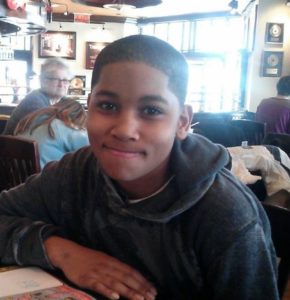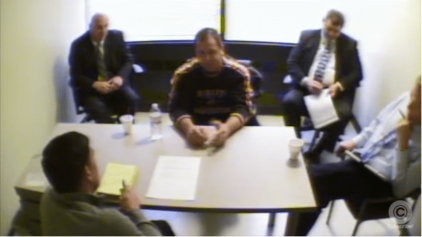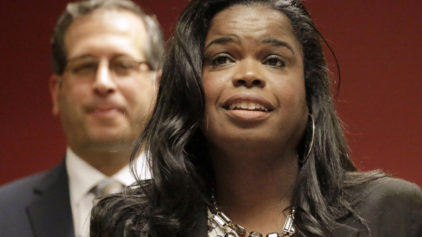
But a New York Times profile of the Rice family and the circumstances surrounding his death revealed a heartbreaking fact: The toy gun he was playing with wasn’t even his—his mother didn’t allow him to play with toy guns because it was too dangerous for a Black boy.
“His mother didn’t allow him around guns whatsoever, toy guns, water guns,” said one of Tamir’s relatives, Deonte Goldsby, 21. “She knows about things like this. She knows that somebody would mistake it for a real gun.”
But an older friend let him borrow the toy, which fired plastic pellets, while the friend took an old cellphone that Tamir had found in his mother’s drawer to the store to see if he could get it activated. The toy was a few years old and the orange safety tip, intended to distinguish it from a real pistol, was no longer there. To Tamir, there was no downside to the swap: He could play with the realistic toy gun—something he didn’t get a chance to do very often because of his mother’s prohibitions—while he waited for his friend to return with a working cellphone.
When Tamir stepped out of his mother’s apartment and wound up across the street in Cudell Commons park with the toy gun, it would trigger a series of disturbing missteps by Cleveland law enforcement that would result in the death of what his family describes as a funny, bright little boy, killed while doing something 12-year-olds do the world over: playing.
“He had a promising future,” his mother said on ABC News. “He was very talented in all sports. He was a wonderful kid. Everybody loved him. He was very helpful, very caring, very kind. He was the youngest out of four. He was my baby.”
As is often the case with tragedies such as these, there were larger bureaucratic decisions made by the city of Cleveland years before that eventually spelled doom for the little boy.
The city used to be committed to something called community policing, a program that stationed police officers across the city in poor communities like the one surrounding Cudell Commons so that they would get to know community residents and reduce the incidences of street crime. There was a police mini-station in the recreation center next to the park where Tamir played basketball. But the mini-station stood deserted, the victim of budget cuts a decade earlier that slashed the community policing program.
The city let go of 250 police officers in 2004 to help close a budget gap. Community policing withered away; mini-stations stood empty.
“If there was one there,” Councilman Jeffrey Johnson told the Times, “he would have known Tamir, because Tamir was a regular, and he would have heard the call and gone out there and said, ‘Tamir, what are you doing?’”
When a caller told the 911 dispatcher that there was “a guy in here with a pistol,” the dispatcher never relayed to the officers that the caller said the gun was “probably fake” and that the person with it was “probably a juvenile.”
Instead, what officers Frank Garmback and his rookie partner, Tim Loehmann, heard was the dispatcher say “We have a Code 1,” which translated as the department’s highest level of urgency. The officers pulled their car right next to the gazebo where Tamir was playing and shot the boy in the stomach from point-blank range within two seconds. Though they later claimed they warned him three times to raise his hands, the surveillance video of the encounter makes that claim highly doubtful.
And as the boy lay dying, the officers failed to provide him with assistance, instead calling for an emergency medical team and then tackling Tamir’s 14-year-old sister to the ground and putting her in handcuffs—and even threatening to arrest his mother Samaria Rice when she arrived on the scene unless she calmed down.
As noted by the Times, it would take eight minutes before EMS workers arrived.
A lawyer representing Officer Loehmann, Henry Hilow, said the officers followed protocol by calling for EMS.
“They were doing the best they could to get medical attention” for Tamir, Hilow said.
As the Times noted, the police department’s policy requires officers to “obtain necessary medical assistance” for injured people but does not explicitly state that they must perform first aid.
But Walter Madison, a lawyer for Tamir’s mother, suggested that if it had been a fellow police officer laying on the ground with a bullet in his stomach, officers would immediately perform first aid.
Hilow said the officers pulled up right next to Tamir to prevent him from running into the recreation center, where they thought he might endanger people.
Hilow said they tried to stop farther away, but the car skidded.
It was subsequently revealed that Loehmann was judged unfit for police work in 2012 by his then-employer, the police department of Independence, Ohio, where a supervisor used words like “distracted,” “weepy,” and “dismal” to describe Loehmann’s handgun performance in an internal memo.
After the boy’s death, Attorney General Eric Holder made a trip to Cleveland and announced that the Justice Department had completed an investigation into the Cleveland police department and was releasing a devastating report detailing the department’s “pattern or practice” of using unreasonable force in violation of the 4th amendment, including unnecessary shootings and head strikes with impact weapons, excessive use of lethal force and “the employment of poor and dangerous tactics.”
The report specifically noted how African-Americans view the department as targeting the African-American community for excessive force and brutality.
The Justice Department found that not only do Cleveland police officers too often use unnecessary and unreasonable force in violation of the Constitution, but that “supervisors tolerate this behavior and, in some cases, endorse it.”


